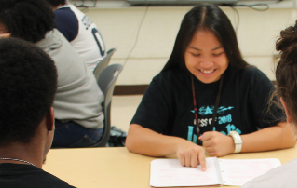Statewide Transition Centers Address Transient Population

Transition Center student facilitator Fallon Villarreal (12) lead a session on improving the center at a recent MYAC meeting.
February 2, 2017
Radford High School’s campus boasts a global community of ethnicities and nationalities, but more than that, a diversity of cultures, opinions, lifestyles, and experiences are found among the 1200-plus student body. New students enroll from around the nation, Europe and Asia, and most of them are children from military families. Radford’s unique environment is attributed to the school’s high percentage, with over 65 percent, of military dependents representing all branches of the armed forces.
Military students enrolling into our local public schools bring a myriad of worldly experiences, but they also harbor challenges associated with a military lifestyle. Radford High School, for the past 11 years, hosts a nationally renown Transition Center with a transformative concept that is invaluable and unique to our school.
In light of what the center provides to our transient population, Transition Centers should be created statewide for all students transitioning into their new schools.
Radford’s Transition Center services all, military and civilian, new students and orients them about the school, community, and Hawaii culture. Former new students turned student facilitators teach a specially designed curriculum which includes four distinct units: looking at the school by knowing school policies, rules, administrators and counselors, adapting to change and coping with stress, charting one’s course and academic passport, and getting to know Hawaii and the community. Most importantly, new students also partner up with student facilitators who serve as lunch buddies.
The Transition Center reported servicing 125 new students since the beginning of the school year, and of that number, 76 percent of them are military dependents.
In the second unit, facilitators address how our military students can adapt to change and cope with stress.
Student facilitator and junior Emily Davis is a military dependent who can empathize with new students.
“We try to talk to them and find out what their interests are and get them into clubs and sports. We have students who are military coming from everywhere. We get people from overseas a lot too, like Italy,” she said. “We have their names on a board along with their grade level and where they came from, so students can hopefully make friends.”
Forming relationships can be a daunting task for military dependents because of their reluctance to initiate and foster bonds with people they will be forced to leave in a few years. Most military families set up temporary residence for up to four years before moving to their next station. For many military families, constant and temporary moves prevent them from establishing roots.
Another common stressor is absent parents due to deployment. Military students may lose a parent for up to over a year, which places a heavy strain on the family left behind.
Senior Madison McHenry recognizes that her father was gone for a majority of her life when he was deployed on 12 occasions, and was gone up to 10 months at a time.
The third unit in the center’s curriculum assists students with charting their course and academic passport. When military dependents move to different schools, sometimes they struggle with their new school’s curriculum because schools demonstrate varying degrees of academic expectations, and this challenge is heightened when students are expected to comply with unfamiliar state standards.
The center’s last unit teaches newcomers about Hawaii and the community. Moving to another state or country often brings culture shock for many military students. While Hawaii is part of the United States, the state’s unique culture is a contrast to the rest of the contiguous nation. Students are taught a Hawaiian or pidgin word of the day, and even participate in excursions around the island.
With a sizeable presence at Radford High School, military students welcome the efforts behind the Transition Center, faculty, and administration to address the needs of the military child. While other local public schools may not have a high military population, they can use this concept to create a center with similar curriculum addressing the needs of their students, with lessons designed specifically for the school and its community.
As our students can attest, having such a center emboldens students with compassion and tolerance, which are essential in such a divergent world.


